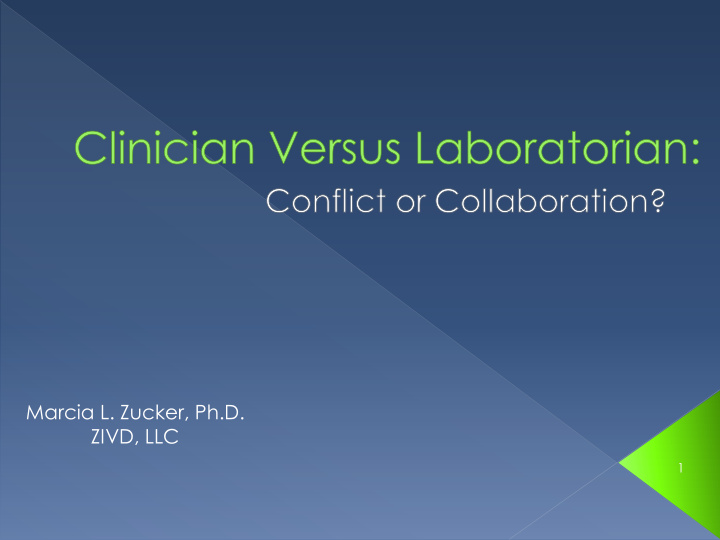



Marcia L. Zucker, Ph.D. ZIVD, LLC 1
Laboratory › Optimized patient care Clinician › Optimized patient care 2
Laboratory Clinician Accuracy Speed High Quality Precision Minimal disruption of Test results routine Compliance 3
https://www.pexels.com/photo/black-and-white-africa-animals-wilderness-3158/ 4
Clinician › If a number is reported, it is correct Laboratory › Evaluation performed before putting a test into clinical use › Each result evaluated › Limitations and interferences evaluated › Reevaluated regularly to ensure appropriate performance 5
Collaboration › Train caregiver on limitations and potential interferences › Discuss need to evaluate results based on patient presentation 6
Clinician › Implement POC for everything Laboratory › Evaluate TAT, Lab process Would changes answer clinician needs? › Implement POC as needed If result not acted upon immediately, no need for POC Workflow changes may be needed to optimize POC implementation 7
Collaboration › What? Evaluation of request for specific POC test Formal process › Why? Need the result now Salesman was convincing Require evidence of clinical need › Who? › When? › How? 8
Collaboration › What? › Why? › Who? Lab and clinicians working together ad hoc or standing committee › When? Defined timelines › How? Studies, P&P, training, etc. 9
Studies › Accuracy / precision Lab or operators? Include ease of use evaluation? P & P › Lab to draft › Clinician to revise › IQCP? Lab template completed by group? Training › Key clinical caveats 10
QC, Proficiency testing and competency take time from patient care Is there value? › other than compliance Why should I, the clinician, bother? 11
Maintain high quality testing Requires clinician time Substantiate need through risk analysis 12
Direct correlation of quality test results and improved patient care Include clinician in the assessment › How wrong is clinically wrong? › What clinical presentation might indicate an erroneous result › How can risks be mitigated? Demonstrate appreciation for clinician expertise 13
Demonstrate risk reduction through quality practices › QC mitigates risk of erroneous result (hopefully) Step by step evaluation of risk reduction through training and competency assessment There are reasons for interruptions of routine › Alter workflow to minimize disruption 14
Reduce conflict and stress › Discussion rather than confrontation Develop people who want to help › Respect for expertise works both ways Encourage consistent operator compliance › Increased accuracy of POCT 15
Foster more willing compromise › Mutual respect reduces confrontation Stimulate open and direct discussions › Easier to cooperate with someone who listens Produce faster solutions to challenges › Expertise from both approaches 16
High Quality Test Results http://www.jonathancliff.com/2014/06/finding-common-ground/ 17
High Quality Testing + Compliant Program + Content Clinicians 18
19
Marcia L. Zucker, Ph.D. ZIVD, LLC mlzucker.zivd@gmail.com 20
Recommend
More recommend